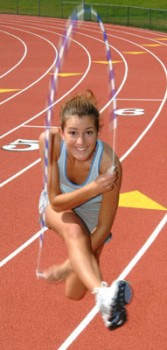JJummmpprrroope!

Details
Everyone starts with a beginning pose. Felicia Hutchinson's favorite has one of her hands behind her back, and her rope hooked over her right foot. She kicks it off and begins with a multiple "under" part. She does a "TJ", which is a triple "under" (rope passes under foot) trick: for the very first jump, she hits the rope to the side; for the second, she jumps in a "toe" position — left hand under right leg, right arm crossed over; then the third jump is normal, a simple swooosh/thhpp! as the rope grazes the ruddy surface of the Haverford track, where Felicia is patiently (well, nearly), posing for photos in the broiling August heat.
She's won gold medals in the double-dutch and free-style competitions of the U.S. Amateur Jump Rope Federation (USAJRF — comprising 63 participating teams and 800 jumpers this year — there are literally hundreds more — from nine regions of the country), competing fiercely but with a kind of selflessness that strikes Niki Glover, her former coach at the Indy Air Bears, her Indianapolis hometown team, as remarkable:"From the time she was eight [at Arlington Elementary School], I saw her practice with a dedication you rarely find . . . She went from being another kid on the team to the spirit of the team." And immediately began "passing what she'd learned along," mentoring younger girls and some boys, who were trying to master the difficult sport of competition jumping.
To do this, Ms. Hutchison says she'd practice at least two hours a day, every day, and on Sundays "from noon until you couldn't do it anymore," often with her friends and partners in the gold medal wins, Mary Beth Arnold and Becky Jaggers: "Of course you practice in spurts — your routines in competition only last 45 to 75 seconds, so you have to get your breath." That's because in jump-rope competition, you're using virtually all the muscles in your body, and your mind automatically shifts into the famous "zone" of all great athletic art, where a kind of metamorphosis seems to occur, a concentration so intense you literally can't do anything wrong — Sandy Koufax's fastball; Makarova's dervish whirls; Sugar Ray Robinson's short right hand — an exhausting demonstration of the overcoming of what Norman Mailer has called "the mind/body dichotomy".
Rope-jumping as an organized sport began around 1974 in the U.S. (it seems to have occurred spontaneously as a rite of childhood from medieval times on the streets of England and Europe), but is now organized formally, internationally, in the IRSF, the Federation Internationale de Sault `a la Corde (International Rope Skipping Federation). Teams come together from all over the world every two years — in effect a jump-rope Olympics — with countries vying for first place. In July of this year in Brisbane, Australia, just before her arrival at Haverford, Hutchison, along with Arnold and Jaggers, who attend other colleges, placed seventh in their specialties, double-dutch (in which two girls turn two ropes while a third performs; and free-style, at which Hutchison excels as a "single", mixing jump-rope "vocabulary" with choreographed dance moves and sometimes pure speed: "I can do 170 jumps in 30 seconds, and 308 in a minute.") It was the first time Team USA had placed in international competition, where the Japanese, who use a lot of break-dancing moves; the Hungarians, who are very fast; and the Aussies themselves, famous for their "crossing tricks" (fancy skipping involving "slant" moves with ropes and footwork), often dominate. Off this year's performance, the Americans are now noted for their fluidity, their style has the smoothest "flow".
The lure of jumping seems universal: "When you're a little kid, it just makes you happy to jump around," Hutchison laughs. "But I know the best thing jumping has done for me is it's given me crazy opportunities. I've been able to work with underpriviliged children, travel around the country and even outside the country, work with media to try to spread the benefits of jump rope, served as an ambassador for companies like Jump Rope for Heart, and it even helped to get me into Haverford! . . . How did it do that? I've been able to start teams in Indiana and surrounding states, I learned the value of teaching and connecting with kids . . . Colleges look for things like that. Also, it's not your typical activity. It's interesting to most people . . ."
A few other things brought Felicia Hutchison to Haverford, too: "It's reputation for great research. I'm interested in biology, and I may concentrate in neural and behavioral sciences. Everyone here is so smart, and also helpful and friendly."



